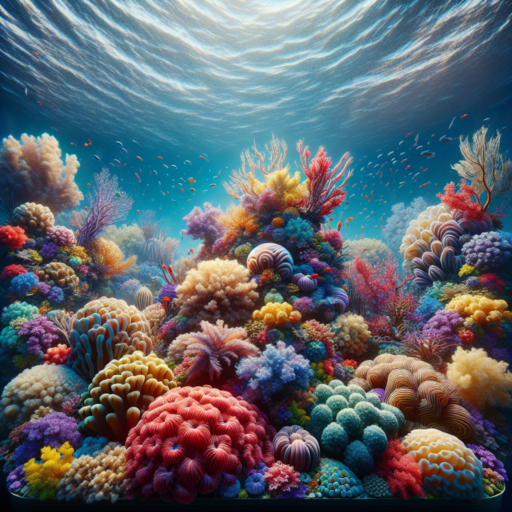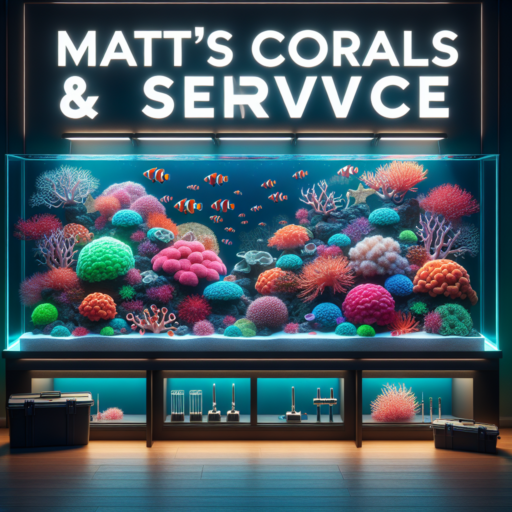Introduction to Ultimate Corals
Welcome to the vibrant and colorful world of Ultimate Corals, where the beauty and diversity of marine life take center stage. As enthusiasts and caretakers of the underwater realm, it’s essential to understand the myriad of coral species available and how they contribute to the ecological balance of marine ecosystems. Our journey through the introduction to Ultimate Corals aims to shed light on these mesmerizing creatures, offering insights into their significance and the role they play within aquatic habitats.
Ultimate Corals encompasses a vast array of species, each with unique characteristics, colors, and growth patterns. These living organisms are not just mere decorations for aquariums but are fundamental components of the ocean’s biodiversity. They serve as critical habitats for various marine life, providing shelter, food, and breeding grounds. This makes understanding and preserving corals an essential aspect of marine conservation efforts and sustainable aquarium keeping.
In the realm of Ultimate Corals, both novice and experienced aquarium enthusiasts can discover the fascinating world of coral care, propagation, and conservation. From the resilient stony corals that build the backbone of reefs to the soft, flowing polyps that add movement and life to any tank, each type brings its own set of challenges and rewards. By delving into the characteristics, needs, and ecological roles of these creatures, hobbyists can make informed decisions, contributing to the health and diversity of their aquariums and the broader marine environment.
The Ultimate Guide to Choosing Your Coral Species
Deciding on the ideal coral species for your aquarium is a thrilling yet complex task. The underwater world is brimming with a myriad of colors, shapes, and sizes of corals, each requiring different care levels. This guide aims to shed light on the essential factors to consider when selecting corals, ensuring a vibrant and healthy aquarium.
Understanding Coral Requirements
Before diving into the vast options available, it’s crucial to understand the specific needs of different coral species. Light, flow, and water quality are the trifecta of coral care. Soft corals, for instance, often thrive in low to moderate light and flow, making them excellent choices for beginners. On the other hand, SPS (Small Polyp Stony) corals demand high lighting and strong water flow, catering to more seasoned aquarium enthusiasts. Recognizing these requirements will serve as your compass in navigating the coral selection process.
Compatibility and Aesthetics
Another significant aspect to consider is the compatibility of coral species within your aquarium. Certain corals have aggressive tendencies, deploying sweeper tentacles or harmful chemicals to outcompete their neighbors for space and resources. Thus, planning your aquarium layout and researching potential coral interactions will avoid any unwanted clashes in your underwater community. Moreover, the aesthetic appeal of corals — from their mesmerizing colors to unique formations — plays a vital role in creating a visually stunning aquascape. Brain corals, with their intricate patterns, and zoanthids, known for their vivid hues, are popular choices among aquarists aiming to enhance the visual allure of their tanks.
Caring for Your Ultimate Corals: Essential Tips and Tricks
Maintaining a vibrant coral reef in your aquarium requires more than just a passion for marine life; it necessitates a deep understanding of the conditions under which corals thrive. The balance of light, water quality, and nutrition is paramount. In this segment, we’ll dive into the essential tips and tricks that can help you provide the best care for your ultimate corals, ensuring they not only survive but flourish in their aquatic habitat.
Optimizing Light Conditions
Corals are phototropic organisms that rely on light for photosynthesis, performed by the symbiotic algae living within their tissues. This process is critical for their growth and energy. Therefore, ensuring the right intensity and spectrum of light is crucial. LED lighting systems, which simulate the natural light spectrum of the sun, are often recommended for their efficiency and effectiveness in promoting coral health and coloration.
Achieving Ideal Water Conditions
Water quality can’t be overstated when it comes to coral care. Corals are particularly sensitive to changes in water parameters such as temperature, salinity, pH, and the presence of nitrates and phosphates. Regular water testing and maintenance are necessary to keep these parameters within the ideal range for your specific coral species. Implementing a reliable filtration system, alongside periodic water changes, will greatly contribute to your corals’ wellbeing.
Feeding Your Corals
Though many corals benefit from the nutrients produced by the photosynthesis of their resident algae, some also require additional feeding to thrive. The feeding needs can vary significantly between species, but most corals will benefit from the occasional feeding of phytoplankton or zooplankton. For the best results, tailor your feeding practices to the specific needs of your coral species, taking care not to overfeed and thus avoid polluting the tank water.
The Top Ultimate Coral Species for Your Aquarium
Adding corals to your aquarium not only enriches the underwater scape with vibrant colors and interesting textures but also supports the ecological balance within your marine setup. Selecting the right coral species can be a turning point in achieving a thriving aquatic environment. This guide highlights some of the ultimate coral species that are not only visually striking but are also known for their resilience and ease of care, making them perfect for both novice and experienced aquarists.
Soft Corals: Ideal for Beginners
Among the plethora of choices, soft corals stand out for their ease of maintenance and suitability for those new to reef keeping. Species like the Leather Coral and Mushroom Coral are renowned for their hardy nature and ability to adapt to different light and flow conditions. These corals exhibit a range of glowing colors and engaging movements that add a dynamic element to any aquarium.
LPS Corals: Adding Structure to Your Reef
Large Polyp Stony (LPS) corals offer an awe-inspiring diversity, adding significant structure and depth to aquatic landscapes. Species such as the Frogspawn Coral and Hammer Coral are particularly coveted for their mesmerizing appearance and the way they sway with the water’s current. Their care requirements are moderate, making LPS corals a rewarding challenge for reef enthusiasts looking to level up from soft corals.
SPS Corals: For the Experienced Aquarist
Small Polyp Stony (SPS) corals are the pinnacle of reef keeping, representing both a challenge and an unparalleled reward for the experienced aquarist. Iconic species like the Acropora and Montipora are celebrated for their intricate shapes and stunning colorations. These corals require precise water conditions and lighting but contribute to a dynamic and compelling reef aquarium that is sure to captivate any observer.
Creating the Perfect Environment for Ultimate Corals
Creating the ultimate environment for corals is both an art and a science, requiring a balance of light, water, and nutrients to thrive. To achieve the ideal conditions for coral growth and health, understanding the specific needs of your coral species is crucial. This includes the intensity and spectrum of light, water flow, and the composition of minerals and nutrients in the water.
Optimizing Light Conditions for Corals
Light plays a pivotal role in the health and coloration of corals. Most corals need a considerable amount of light to perform photosynthesis, a process that is vital for their growth. Utilizing a combination of LED and T5 lighting can mimic the natural spectrum of sunlight, promoting vibrant colors and strong growth in corals. Adjusting the light intensity and duration to match the natural light cycles will ensure your corals receive the energy they need without being exposed to excessive light, which can lead to bleaching.
Water Quality and Flow: The Lifeline of Corals
Water quality cannot be overstated when it comes to creating the perfect environment for corals. Salinity, pH level, and temperature must be maintained within a precise range to mimic the natural seawater conditions. Moreover, the introduction of water movement through powerheads or wave makers not only distributes nutrients evenly but also prevents the accumulation of harmful waste products. A moderate, erratic water flow simulates the natural currents of a coral reef, providing an ideal setting for corals to flourish.
By focusing on these key factors, hobbyists can create an ideal underwater ecosystem that promotes the health and growth of corals. Understanding the intricate balance required in a reef tank is essential in bringing out the best in your coral collection.
Ultimate Corals Health and Disease Prevention
Maintaining the health of corals and preventing disease is crucial for the sustainability of marine ecosystems. The balance within these underwater environments relies heavily on the well-being of coral species. To ensure the ultimate health and disease prevention of corals, it’s indispensable to understand both the threats they face and the measures that can be taken to protect them.
Identifying Common Coral Diseases
Diseases affecting corals can have devastating effects on coral reefs. Identifying the symptoms of common diseases is a key step in managing coral health. Conditions such as White Band Disease, Black Band Disease, and Coral Bleaching are among the most prevalent threats. These diseases are characterized by the discoloration and gradual degradation of coral tissues, often leading to significant reef damage if not addressed promptly.
Preventative Measures and Health Strategies
To combat the onset of diseases in corals, several preventative measures can be implemented. Ensuring clean and stable water conditions is fundamental. Regular monitoring of water parameters such as temperature, pH, and salinity can help maintain an environment that supports coral health. Moreover, the implementation of quarantine protocols for new additions to coral habitats can prevent the introduction of pathogens. Additionally, the promotion of biodiversity within reefs can bolster the resilience of corals against diseases.
Advancements in coral research have highlighted the importance of proactive health management practices. Techniques such as coral gardening and selective breeding for disease resistance are emerging as vital tools in the effort to preserve coral ecosystems. These innovative strategies not only aim to enhance the natural resilience of corals but also to rehabilitate reefs that have already been impacted by disease and deterioration.
Feeding Your Ultimate Corals: Best Practices
When it comes to maintaining a vibrant, healthy coral reef aquarium, understanding the dietary needs of your corals is vital. Corals are unique animals that require a specific balance of nutrients to thrive. This guide delves into the best practices for feeding your ultimate corals, ensuring they remain in peak condition and display their most vivid colors.
Identify Your Corals’ Nutritional Needs: Not all corals are created equal when it comes to their feeding habits. SPS (Small Polyp Stony) and LPS (Large Polyp Stony) corals, for example, have different nutrient requirements. SPS corals generally rely more on photosynthesis performed by their symbiotic zooxanthellae, whereas LPS corals may benefit from direct feeding of meaty foods or high-quality coral foods. Understanding the specific needs of your coral species is the first step in creating an optimal feeding regimen.
Choosing the Right Coral Food: With a myriad of coral foods available in the market, selecting the right one can be daunting. High-quality, specially formulated coral foods are designed to mimic the natural diet of corals in the wild. These foods often contain a blend of phytoplankton, zooplankton, and other essential nutrients that corals thrive on. Be cautious with the quantity, as overfeeding can lead to poor water quality and other negative side effects.
Feeding Techniques and Schedule
- Targeted Feeding: This method involves directly feeding specific corals using tools like basters or pipettes. It’s especially beneficial for LPS corals that can consume larger food particles.
- Broadcast Feeding: This approach is suitable for feeding a wide range of coral species at once. It involves dispersing food throughout the aquarium, allowing corals to capture the particles from the water column.
- Feeding Schedule: Consistency is key for coral health. Establishing a regular feeding schedule helps mimic the natural feeding patterns of corals, promoting their well-being and growth. Adjust the frequency based on your corals’ specific needs and observe their response to find the optimal schedule.
Propagating and Breeding Ultimate Corals
Propagating and breeding ultimate corals is a fascinating aspect of reef aquarium keeping that captivates many enthusiasts. This practice not only enhances the beauty and biodiversity of home aquariums but also contributes to coral conservation efforts globally. Understanding the fundamental techniques and conditions necessary for coral propagation can transform an ordinary reef tank into a thriving ecosystem.
Essential Techniques for Successful Coral Propagation
To successfully propagate corals, hobbyists must become familiar with fragging, a common method where fragments of parent corals are carefully separated and encouraged to grow as new colonies. Selecting the right tools, such as coral cutters or bone shears, is crucial for minimizing stress and damage to both the parent and the fragment. Moreover, ensuring optimal water conditions and lighting is paramount for the fragments to establish and thrive.
Choosing the Right Coral Species for Propagation
Not all corals are suitable for propagation, and recognizing the best candidates is key to a successful venture. Soft corals, such as Xenia or Pulsing Xenia, and some hard corals like Acropora and Montipora, are among the favorites for hobbyists due to their resilience and growth patterns. Understanding the specific needs and growth rates of these corals can greatly increase the chances of propagation success.
Common Challenges with Ultimate Corals and How to Overcome Them
Maintaining ultimate corals in an aquarium can be a rewarding yet challenging experience for both novice and experienced aquarists alike. Despite their vibrant beauty and appeal, corals face several common challenges that can affect their health and growth. Understanding these hurdles is the first step towards creating a thriving coral ecosystem.
1. Algae Overgrowth
Algae overgrowth is a frequent issue in coral aquariums, competing for essential nutrients and light. This competition can stress corals out, leading to decreased growth and vitality. Managing nutrient levels by regular water changes, using phosphate absorbers, and maintaining proper lighting can help prevent algae from taking over your coral habitat.
2. Inadequate Water Parameters
Corals are quite sensitive to the quality of water in which they reside. Fluctuations in water temperature, pH levels, and salinity can stress corals, making them more susceptible to diseases. Utilizing reliable water testing kits to monitor these parameters regularly, ensuring the use of a high-quality water source, and investing in a robust filtration system are crucial steps in maintaining optimal conditions for corals.
3. Pests and Diseases
Another significant challenge faced by coral enthusiasts is the threat of pests and diseases. Parasites like flatworms and ailments such as coral bleaching can devastate coral populations. Early detection through regular inspection, quarantining new coral additions before introducing them to your tank, and using coral dips can help in preventing and controlling these issues, keeping your corals healthy and vibrant.
Frequently Asked Questions About Ultimate Corals
When it comes to setting up or maintaining a marine aquarium, corals are often a focal point due to their vibrant colors and unique structures. Ultimate Corals has become a preferred choice for many enthusiasts, leading to several common inquiries. Understanding these questions can help both novices and seasoned aquarium keepers make informed decisions about their aquatic environments.
What Types of Corals Are Best for Beginners?
Starting with hardy and forgiving species is often recommended for those new to coral care. Species such as Zoanthids, Mushrooms, and Leather corals are not only beautiful but also less demanding regarding water conditions and lighting. These corals provide an excellent starting point for understanding the basics of coral care without overwhelming the new hobbyist.
How Often Should I Feed My Corals?
The feeding frequency for corals depends significantly on the type of corals you have and the specific conditions of your aquarium. While some corals may benefit from daily feeding, others might only require feeding once or twice a week. Observing your corals’ behavior and growth can help you adjust feeding schedules to meet their needs effectively.
Do Corals Need Special Lighting?
Lighting plays a crucial role in the health and growth of corals. Ultimate Corals, especially those with symbiotic algae known as zooxanthellae, require specific intensities and spectra of light to thrive. LED lighting systems that mimic natural sunlight patterns are often recommended for promoting optimal coral health and vibrancy.









